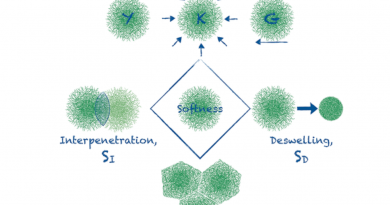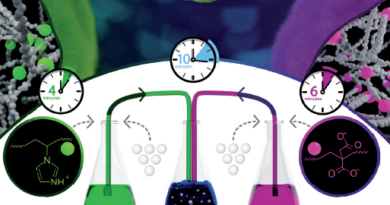SFB 985 on the cover of LANGMUIR
Influence of Architecture on the Interfacial Properties of Polymers: Linear Chains, Stars, and Microgels
Surface-active polymers have important applications as effective and responsive emulsifiers, foaming agents, and coatings. In this contribution, we explore the impact of the polymer architecture on the behavior at oil–water interfaces by comparing different poly(N-isopropylacrylamide) (pNIPAM)-based systems, namely, monolayers of linear and star-shaped macromolecules, ultralow cross-linked, regular cross-linked, and hollow microgels. Compression isotherms were determined experimentally as well as by computer simulations. The latter provides information about the conformational changes of the individual macromolecules as well as the interfacial properties of the monolayer, including the surface structure and the density distribution of an ensemble of interacting macromolecules near an interface. Surprisingly, the isotherms of the linear polymer, of the star polymer, and of the ultralow cross-linked microgel have an identical shape that differs from the isotherms of regular and hollow microgels. We introduced the mass fraction of adsorbed polymer, which gives a measure of the polymer segments contributing to the isotherm in relation to the most flexible architecture, i.e., the linear polymer, and allows a comparison of polymers with different architectures. The data demonstrate that increasing the number of cross-links leads to a significantly lower amount of polymer in the proximity of the interface as the increase in cross-linker reduces the deformability or softness of the polymers at the interface. The volume fraction profiles along the normal to the interface are essentially different in the microgel monolayers as compared to those in the linear and star polymer. The profiles through the microgel contact line and their growth upon initial compression are similar to those of the linear chains. Herewith, the profiles through the center of mass practically do not change upon compression. Therefore, the initial growth in the microgel surface pressure reveals the polymer-like behavior and is related to the deformation of the peripheral part of the microgel. Further compression of the microgel monolayer leads to 3D interactions of the microgels within the aqueous side of the interface and soft colloid-like behavior.
Steffen Bochenek, Andrey A. Rudov, Tim Sassmann, Igor I. Potemkin and Walter Richtering
DOI paper: https://doi.org/10.1021/acs.langmuir.3c02470



